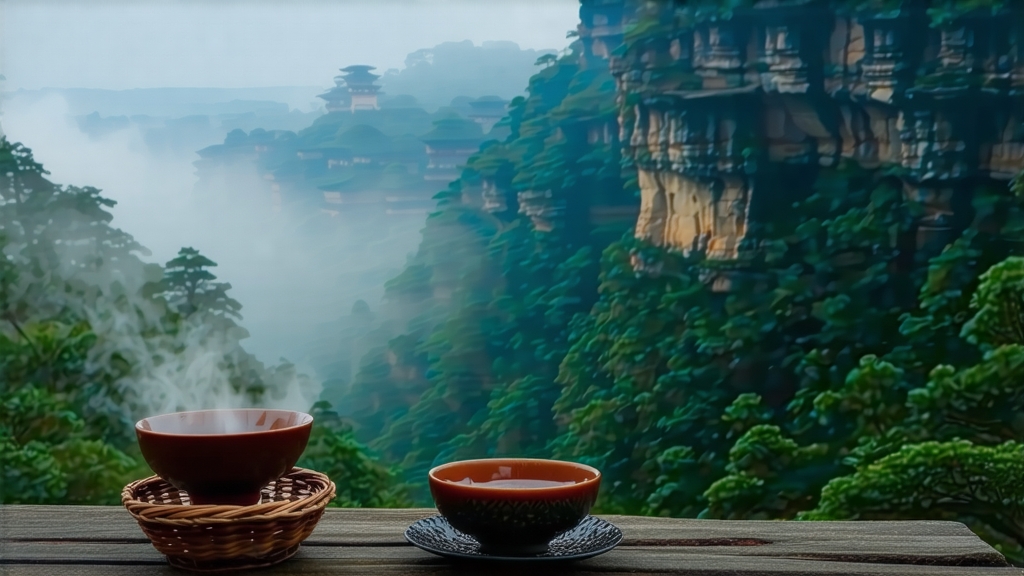
When Chinese tea lovers speak of “rock rhyme”—the elusive yan yun that signals the highest grade of Wuyi oolong—they are, knowingly or not, invoking the spirit of Da Hong Pao. Literally “Big Red Robe,” this legendary tea is less a single cultivar than a micro-ecology of history, geology and craft squeezed into a few precipitous kilometers of Fujian’s Wuyi Mountains. To the international drinker accustomed to neatly labeled Assam or Darjeeling, Da Hong Pao can feel almost mythic: mother trees growing out of nearly vertical cliff faces, imperial robes said to have once shielded them from the sun, and prices that have topped one million dollars per kilogram at government auctions. Yet beyond the lore lies a drink whose layered fragrance, enduring sweetness and unmistakable mineral backbone have made it the benchmark for all mid-oxidized, charcoal-roasted oolongs. Understanding Da Hong Pao is therefore a doorway into the wider universe of Chinese oolong, a style that sits greenly fragrant at one end and deeply roasted at the other, but always insists on the alchemy of time, fire and stone.
Historical scrolls first mention “Yan Cha” (cliff tea) during the Song dynasty (960-1279), when Wuyi monks bartered compressed tea bricks for imperial protection. The name Da Hong Pao appears later, in the early Ming, tied to a tale in which a Ming-dynasty scholar, en route to the capital for imperial exams, was revived by local monks with a brew so restorative that he went on to top the exams. He returned in crimson official robes—da hong pao—to drape the bushes that had saved him, an act that supposedly reddened their leaves forever. Whether apocryphal or not, the story cemented the tea’s prestige; by the Qing, Da Hong Pao was listed among the “Five Famous Teas” presented at the imperial court. The 20th century saw the original six mother trees—clinging to a cleft called Jiulong Ke—nationalized and eventually protected; cuttings taken in the 1980s created the so-called “purebred” or qizhong offspring that now constitute most legitimate market supply. Today the mother trees themselves are no longer harvested, their genetic legacy preserved in arboretums while skilled cloners replicate their mineral-loving root systems across the Wuyi core sub-region known as Zhengyan, literally “true cliff.”
Da Hong Pao is not a single genetic line but a blend of three indigenous Wuyi cultivars—Qidan, Beidou and Que She—each prized for its ability to absorb and refract the terroir of volcanic tuff, narrow gorges and ever-drifting mist. Within Zhengyan, micro-valleys such as Huiyuan Keng, Niulan Keng and Liang Xiang Jian yield leaves whose amino-acid profile differs measurably from bushes planted even 200 meters outside the protected zone. The Chinese industry grades these lots as “special true cliff,” “first-cliff,” “half-cliff,” and finally “river-side” or “outside mountain,” terms that parallel Burgundy’s Grand Cru hierarchy. Leaves picked at the Qingming window—usually three to five days in mid-April—carry the highest concentration of floral volatiles, yet must be processed within hours of plucking to prevent the mountain humidity from triggering premature oxidation.
Processing Da Hong Pao is a 24-hour choreography that begins with sun-withering on bamboo mats set into terraced courtyards. For roughly thirty minutes the leaf loses about 10 % moisture, softening cell walls for the critical bruising stage. Tossing and tumbling in a waist-high bamboo drum follows, a motion that ruptures leaf edges while keeping the veins intact; this partial oxidation—stopped at 30–50 % rather than the 70–80 % of black tea—creates the green-center, red-fringe leaf that oolong connoisseurs recognize as “green dragon with red rim.” After brief rest, the leaf is heated in a 200 °C electric tumblers for fixation, arresting enzymes and locking in floral aromatics. What distinguishes Wuyi oolong from its southern cousin Tie Guan Yin is the next step: charcoal roasting. Traditionally done in a squat clay oven fueled by locally harvested hardwood, the tea is baked in shallow bamboo sieves at temperatures that cycle between 80 °C and 120 °C over six to twelve hours. Masters repeat this roasting